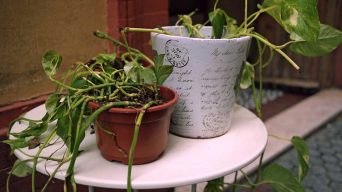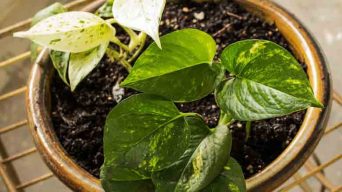Pothos plants are one of the most popular houseplants, for a good reason!
They’re easy to care for, tolerant of a wide range of conditions, and can even help purify the air in your home.
However, even the hardiest indoor plants can suffer from neglect, and one of the most common problems pothos plants face is underwatering.
Here’s everything you need to know about recognizing, treating, and preventing underwatered pothos.
Why Is Underwatering A Problem?
All plants need water to survive, and pothos plants are no exception.
While they are tolerant of a wide range of conditions, they will eventually start to suffer if they don’t get enough water.
Water is essential for plants because it helps them transport nutrients and minerals from the soil to the rest of the plant.
It also helps create energy and food for the plant through photosynthesis.
In short, without water, plants can’t do much of anything!
That’s why ensuring your pothos plant is getting enough water is essential.
If you don’t, it will start to suffer from a whole host of problems, including:
The Plant Stop Growing
When a pothos plant doesn’t get enough water, the first thing that will happen is that its growth will stop.
Without water, the plant can’t transport nutrients and minerals to its leaves and stems, so it will stop growing.
This is one of the easiest ways to tell if your pothos plant is underwatering.
If you notice that it’s not growing as quickly as it used to or that new leaves are taking longer to appear, it’s a good sign that the plant is not getting enough water.
Root Rot
Another common problem caused by underwatering is root rot.
Root rot is a condition that happens when the roots of a plant start to decompose.
This can happen for several reasons, but one of the most common is lack of water.
Without water, the roots of a plant can’t get the oxygen they need to stay healthy, so they start to break down.
This can eventually lead to the death of the pothos plant.
The Plant Becomes Susceptible To Pests and Diseases
Underwatering can also make a pothos plant susceptible to pests and diseases.
When a plant doesn’t have enough water, it cannot produce the energy it needs to fight off pests and diseases.
This means that if your pothos plant does get infested with pests or diseases, it will be much harder for it to recover.
The Plant Starts To Die
If you don’t correct the problem of underwatering, eventually, the pothos plant will start to die.
This is because the plant will run out of energy to survive.
Without water, the plant can’t produce food through photosynthesis, and it can’t transport nutrients and minerals to its leaves and stems.
Eventually, the plant will just run out of energy and die.
How Does Underwatering a Pothos Plant Occur
Now that we’ve seen some of the problems that can occur when a pothos plant is underwatered let’s look at how it happens.
There are a few different ways underwatering can occur, and it’s essential to be aware of all of them to prevent it from happening to your pothos plant.
Not Watering the Plant Enough
This is the most common cause of underwatering.
Pothos plants are tolerant of a wide range of conditions, but they still need to be watered on a regular basis.
If you’re not watering your pothos plant enough, it will eventually start to suffer from the problems we’ve seen above.
It’s essential to make sure you’re watering your pothos plant enough, especially during the summer when it’s growing the most.
A good rule of thumb is to water the plant once a week or whenever the soil starts to feel dry.
Using the Wrong Soil
Another common cause of underwatering is using the wrong soil.
Pothos plants prefer a light, well-draining soil.
If you’re using a heavy, clay-based soil, it will hold onto too much water, and the roots of the plant will start to rot.
To prevent this, ensure you’re using a light, well-draining soil.
You can also add some perlite or sand to the soil to help it drain better.
Using the Wrong Pot
Your pot size can also affect how often you need to water your pothos plant.
If you’re using a pot that’s too small, the roots will start to crowd, and the plant will dry out quickly.
On the other hand, if you’re using a pot that’s too large, the soil will stay too wet, and the pothos plant will suffer from root rot.
To prevent this from happening, make sure you’re using a pot that’s the right size for your pothos plant.
Not Using a Pot with Drainage Holes
Pothos plants also need a pot with drainage holes.
If the pot doesn’t have drainage holes, the water will sit in the bottom of the pot, and the roots will start to rot.
To prevent this, make sure you’re using a pot with drainage holes.
Hot, Dry Weather
Hot, dry weather can also cause underwatering.
If the weather is hot and dry, the soil will start to dry out quickly, and the plant will need to be watered more often.
To prevent this, ensure you water your pothos plant more often during hot, dry weather.
Check the soil regularly and water the plant when the soil starts to feel dry.
Too Much Sunlight
Pothos plants prefer bright indirect light.
If the plant is getting too much sunlight, the soil will dry out quickly, and the plant will start to suffer from the problems we’ve seen above.
Ensure you’re not putting your pothos plant in direct sunlight to prevent this.
Move the plant to a shadier spot if it’s getting too much sun.
Repotting the Plant Too Often
Pothos plants don’t need to be repotted very often.
Repotting them too often can cause problems.
When you repot a pothos plant, you disturb the roots, which can cause underwatering.
To prevent this from happening, only repot your pothos plant when necessary.
If the plant is getting too big for its pot or the roots are starting to crowd, it’s time to repot.
Otherwise, leave it be.
Diseases
Pothos plants are susceptible to various diseases, including root rot and leaf spot.
Root rot is caused by a fungus attacking the plant’s roots.
Leaf spot is caused by a fungus that attacks the plant leaves.
Diseases can damage the plant and make it more susceptible to underwatering.
Ensure you’re not overwatering your pothos plant to prevent this from happening.
Water pothos plant only when the soil starts to feel dry, and make sure the pot has drainage holes so the water can drain out.
Pest Damage
Pests can also damage pothos plants and make them more susceptible to underwatering.
Aphids, mealybugs, and scale are all common pests that can attack pothos plants.
Pest damage can weaken the plant and make it more susceptible to underwatering.
To prevent this, check your plant for pests regularly and treat them accordingly.
How To Tell If Your Pothos Plant Is Underwatered
Now that we’ve gone over some of the most common causes of underwatering let’s talk about how to tell if your pothos plant is underwatering.
It’s essential to identify the signs of underwatering so that you can take action quickly and save your plant.
Signs of an Underwatered Pothos Plant
You can look for a few signs to tell if your pothos plant is underwatering.
The most common signs are:
Drooping Leaves
If your pothos plant leaves are drooping, it’s a sure sign that the plant is not getting enough water.
The lack of water will cause the Pothos leaves to droop and eventually turn yellow or brown.
This happens because the plant is not getting the water it needs to support the leaves.
If you see this happening, water your plant immediately.
Yellow Leaves
Another common sign of underwatering is yellow leaves.
Yellow leaves can signify many problems, but underwatering is one of the most common.
This happens because the plant cannot transport the nutrients it needs to the leaves.
The lack of water will cause pothos leaves to turn yellow and eventually die.
If the leaves of your pothos plant are turning yellow, it’s a good idea to check the soil to see if it’s dry.
If the soil is dry, water your plant immediately.
Brown Leaf Tips or Edges
One of the most common problems with pothos plants is browning leaf tips or edges.
This is almost always caused by one thing – watering issues.
Underwatered plants will often have brown, crispy leaves.
This happens because the plant is not getting enough water, and the leaves are drying out.
If you see this happening, water your plant immediately.
Wilting
Wilting is another common sign of underwatering.
When a plant is wilting, the leaves are drooping, and the stems are weak.
This happens because the plant is not getting enough water, and it’s starting to dehydrate.
If you see this happening, water your plant immediately.
Curling Leaves
Curling leaves is another common sign of underwatering.
When the leaves of a plant are curling, they’re not getting enough water.
The lack of water will cause the pothos leaves to curl and eventually die.
Curling leaves can also be a sign of pests, but it’s more common in underwatered plants.
If you see this happening, water your plant immediately.
Dry or Cracked Soil
If the soil around your pothos plant is dry or cracked, it’s a sign that the plant is not getting enough water.
When the soil dries out, it will start to crack and pull away from the sides of the pot.
If you see this happening, water your plant immediately.
Slow Growth
Underwatered plants will often have slow growth.
This happens because the plant is not getting the water it needs to support new growth.
If you see that your pothos plant is not growing as quickly as it should be, check the soil to see if it’s dry.
If the soil is dry, water your plant immediately.
Leaf Drop
If your pothos plant is dropping leaves, it’s a sign that the plant is not getting enough water.
The lack of water will cause the leaves to drop off the plant.
This happens because the plant cannot transport the nutrients it needs to the leaves.
If you see this happening, water your plant immediately.
How To Save an Underwatered Pothos Plant?
Pothos plants are very resilient and can often be saved even if they already show signs of underwatering.
There are a few things you can do to save your plant.
Water Your Plant Immediately
The first and most important thing you need to do is water your plant immediately.
Water deeply until the water runs out of the drainage holes.
Don’t water again until the soil is dry to the touch.
This will help to rehydrate your plant and prevent further underwatering.
Give Your Plant a Humid Environment
If you live in a dry climate or your home is very dry, it’s a good idea to give your plant a more humid environment.
You can do this by placing the pot on a tray of pebbles and water.
The water will evaporate and help to increase the humidity around the plant.
You can also use a humidifier to help increase the humidity around your plant.
Fertilize Your Plant
If your plant looks especially sick, it’s a good idea to fertilize it.
This will help to give the plant the nutrients it needs to recover.
Use a fertilizer that’s high in nitrogen and phosphorus.
These are the two nutrients that plants need the most for healthy growth.
You can fertilize your plant once a month during the growing season.
Prune Your Plant
If your plant looks especially sick, you may need to prune it.
Pruning will help to get rid of any dying or dead leaves.
It will also help to encourage new growth and help your plant to recover.
To prune your plant, cut off any dead or dying leaves.
You can also cut off any stems that are weak or thin.
Be sure to use sharp, clean pruning shears.
This will help to prevent infection and encourage healing.
Use the Proper Size Pot
If your plant is pot-bound, it may struggle to get enough water.
When a plant is pot-bound, the roots have filled up the pot, and there’s no room for them to grow.
This can make it difficult for the plant to absorb water.
If your plant is pot-bound, repot it’s a good idea.
Use a pot that’s one size larger than the current pot.
Use the Right Soil
If you’re using the wrong type of potting soil, it may be difficult for your plant to get the water it needs.
Soil that’s too dense or too sandy can make it difficult for water to penetrate.
It’s a good idea to use a light, well-draining soil.
A good option is a cactus or succulent potting mix.
This type of soil will help ensure your plant gets the water it needs.
Check the Drainage
If your pot doesn’t have drainage holes, it may be difficult for water to penetrate the soil.
When water can’t penetrate the soil, it will sit on top of it, making it difficult for the plant to absorb.
If your pot doesn’t have drainage holes, you can drill some into the bottom of the pot.
You can also use a pot with a built-in drainage system.
This type of pot will have holes in the bottom that allow water to drain out.
You can also use a pot with a saucer.
This type of pot will have a hole in the bottom that allows water to drain out.
The saucer will catch the water and prevent it from draining out too quickly.
Check the Roots
If the roots of your indoor plant are damaged, it may be difficult for the plant to absorb water.
Roots can become damaged by pests, diseases, or even physical damage.
If you suspect that your plant’s roots are damaged, it’s a good idea to check them.
To check your plant’s roots, carefully remove the plant from its pot.
Check the roots for any signs of damage.
If you see any damage, you can trim away the damaged roots.
You can also repot the plant in fresh soil.
This will help to encourage new growth.
Monitor Your Plant
Once you’ve identified and treated the problem, monitoring your plant is essential.
Check your plant regularly for any signs of stress.
Be sure to check the leaves, stems, and roots.
If you see any new problems, be sure to address them immediately.
Monitoring your plant can help ensure it stays healthy and happy.
How To Prevent Underwatering a Pothos Plant
Pothos plants are tough and can withstand a fair amount of neglect, but they will suffer if they are underwatered.
Here are some tips on how to prevent underwatering your pothos plant:
- Check the soil before watering. Pothos plants like to have their soil moist but not soggy. Stick your finger into the soil up to the first knuckle. If the soil is dry, it’s time to water.
- Water slowly and deeply. When you water your pothos plant, water it slowly and deeply so the water can reach the roots.
- Use a well-draining potting mix. Make sure that your pothos plant is in a pot with a well-draining potting mix. This will help prevent the roots from sitting in water, leading to root rot.
- Don’t let the plant sit in water. After watering your pothos plant, be sure to empty any water that is left in the saucer or pot. Allowing the plant to sit in water can lead to root rot.
- Avoid overwatering. While keeping your pothos plant moist is essential, you should avoid overwatering it. Overwatering can lead to root rot and other problems.
- Know your plant. Get to know your pothos plant and how often it needs to be watered. This will vary depending on the size of the plant, the type of potting mix, the temperature, and other factors.
- Water early in the day. Water your pothos plant early in the day, so the leaves have time to dry before nightfall. This will help to prevent problems with fungal diseases.
- Check for drainage holes. Ensure your pot has drainage holes so the water can drain out. Pothos plants don’t like to sit in water.
- Use tap water or filtered water. Pothos plants are sensitive to the chemicals in tap water, so it’s best to use filtered water or allow the tap water to sit for 24 hours before using it.
- Don’t let the plant stress out. Pothos plants are tough but can still be stressed by too much heat, cold, or drought. Try to keep your plant in a consistent environment to prevent stress.
Final Thoughts
Pothos plant care is pretty simple and straightforward.
With some care, your pothos plant will thrive and look beautiful.
However, if you neglect your plant or don’t give it the care it needs, it may start to experience some problems, like underwatered pothos.
If you think your pothos plant is underwatered, make sure to take action right away.
By properly watering your plant and giving it the care it needs, you can prevent underwatered pothos and keep it healthy and happy.







